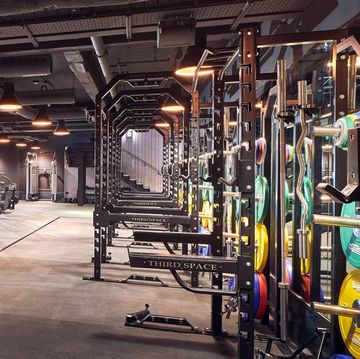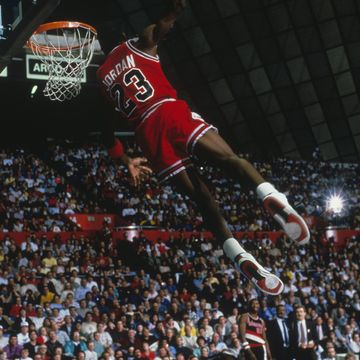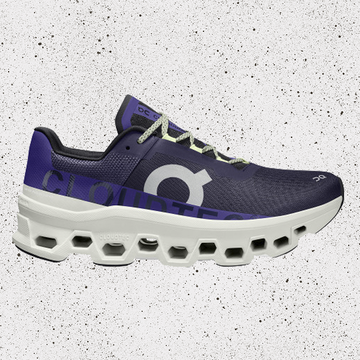The view from atop the pyramids is breathtaking. From the ruins of Monte Albán, with the verdant valleys of Oaxaca spread out at your feet, it's hard not to imagine what the Zapotec people saw when they built these structures almost three thousand years ago. Around the great plaza at the center of the ancient city runs a series of tunnels to tombs, altars, and courts for playing ball games. Throughout you'll find cave paintings and carved stones, including the Danzantes, or "dancers," believed to depict mutilated sacrificial victims whose bodies were destroyed so the culture could thrive. I can picture it all now. I just wish I had been there to see it in person.
I had to ask my wife what it was like to visit, because at the time I was making a pilgrimage to Gimnasio Calipso Centro Histórico, one of about a dozen fitness centers in Oaxaca City. The views from that site, which I scouted out weeks before our trip, weren't quite as remarkable as from Monte Albán. It was a shambling two-story structure painted aqua blue. It looked like a gym. But when you have an eating disorder like mine, no view is beautiful enough to override your compulsion to purge.
After my workout, I went for a nice run in the afternoon rain along the cobblestone streets of the Plaza de la Constitución. Oaxaca is an outstanding culinary destination, you see, and the night before we had eaten a huge meal of Oaxcan cheese, tlayuda, chapulines, and mezcal. I had to earn the next day's meal. In retrospect, the steps of the pyramids would have been a pretty good spot for running stair sprints.
I often tell this story when my wife and I get into conversations about traveling. I relate the anecdote as if it were a quirky character detail: Haha, yes, it's a bit weird, but that's me. There was the time I found myself lifting weights alone in the fitness room of a middle school in the Scottish Highlands, looking like a deranged bench-press pervert, in lieu of a whisky tasting at a distillery. (Later I went running through the gorgeous sheep-filled hills until my phone battery died and I got lost.) Or the time I must have spent $300 on cab rides and guest pass fees to get to Reykjavík's sprawling fitness center with an Olympic-sized outdoor heated pool, doing laps among the universally fit and attractive Icelanders, curse them all. Back home, when the subject of the gym comes up, I tell friends that I go around 360 days a year. Sometimes Christmas gets in the way.
You wouldn't know it by looking at me. I am six feet tall and between 180 and 190 pounds, depending on the month. I am by no means the picture of health or even particularly muscular-looking—not for someone who exercises this much, and definitely not compared to most of the men I see at my gym.
Or maybe I am? That's the problem, or one of them: What I see when I look in the mirror doesn't correspond with reality. I see a fat piece of shit, and then I think to myself that it's time to punish my body for letting me down. Scarcely a half hour of my day goes by when I'm not thinking about when and how I'm going to exercise next, or what food I can and cannot allow myself to eat. Of course I'm not getting bigger, because the body needs rest to build muscle, something I won't give it. And of course I don't get thin enough, because when you starve yourself all day, it's too easy to binge on crap later on.
I used to think that my fitness regimen was admirable, a point of pride, but I've come to recognize it as an eating disorder called exercise bulimia. The Diagnostic and Statistical Manual of Mental Disorders doesn't specify exercise bulimia as its own illness, but it is categorized as a subset of bulimia nervosa. The difference is instead of vomiting or abusing laxatives, a person will use compulsive exercise as a form of purging. Exercise bulimia manifests itself in different ways—from excessive exercise to compensate for calories consumed, to starving oneself but continuing to exercise, to an all-consuming obsession with exercise to the point of serious self-harm, as in my case at the moment. In all cases, the results can be debilitating, both mentally—emotional distress when you're unable to exercise sufficiently—and physically—bone density loss from lack of nutrition, joint pain, constant muscle soreness, recurring injuries, and persistent fatigue.
Today, I will run and lift weights, despite instructions from my doctors to take it easy this year as I deal with a back injury. I will run until my knees ache and my back stiffens, and I will manage the ensuing pain with too much Advil. Being skinny, even with back pain, feels a lot better than being chubby. And then, once I feel I have earned it, I will eat a large meal, thereby resetting the cycle of guilt, and begin the process all over again tomorrow. It's a problem as destructive as any other type of addiction, which, if we're being forthcoming, I also have plenty of experience with.
Studies have found a correlation between people who suffer from substance-abuse issues and eating disorders, as Eric Strother et al write in "Eating Disorders in Men: Underdiagnosed, Underrated, and Misunderstood." But too often it is the substance abuse itself, and not its relationship to the eating disorder, that is prioritized in treatment. That's particularly true when it comes to men. Or so the thinking goes, because there isn't an overwhelming consensus on much of this stuff. The problem is, unlike early research on substance abuse, which was long considered a male-centric issue, eating disorders have been studied through a primarily female lens. It wasn't until the 1960s that men were even considered in any such studies, and research on the effects and causes of eating disorders in men are still rare. Things have improved, writes Arnold Andersen, one of the preeminent researchers in the field, but there's a long way to go.
Andersen and others point to a shift when the rise of "peak" male form in the action films of the 1980s and 1990s and on the covers of magazines altered our cultural expectations of how men are supposed to look. This magazine and others like it certainly played a part. Men stopped wanting to be like Burt Reynolds and Paul Newman and instead idealized Arnold Schwarzenegger and Sylvester Stallone. Batman and Superman stopped looking like average schlubs and started being portrayed as muscular behemoths, or lithe athletes. Brad Pitt happened. As women have known for much longer, that sort of thing can fuck you up, particularly in your teens and early twenties (which is when men are most commonly diagnosed with eating disorders), Andersen writes. There's another story my wife tells about her first memory of me, long before we started dating, when I came over to hang out with her brother. I was standing in her parents' kitchen looking at my own reflection in the stove. "Am I too broad?" I asked of no one in particular. I was fifteen years old.
While numbers vary on how many men suffer from eating disorders—in part because of the gender bias in studying it—a widely cited study from 2007 found 25 percent of anorexia and bulimia cases occur among men. Another study found 20 million women and 10 million men in the United States will suffer from an eating disorder at some point in their life. (There are no widely agreed upon numbers on exercise bulimia.) But those statistics get complicated by the many men who don't present themselves for treatment, or who don't even realize that they have a problem at all, says Andrew Walen, a spokesman for the National Eating Disorders Association, founder of the Body Image Therapy Center, and author of Man Up to Eating Disorders. "The general cultural understanding is that to speak up about an eating disorder is to feel like you have an un-masculine disease," Walen tells me.
He's right. As someone who has no problem sharing all manner of personal information about himself online every day, and who certainly doesn't consider himself one to conform to outdated gender stereotypes, writing this—even in an email to my editors—felt embarrassing in a way I was unfamiliar with. It felt like coming out as a crazy person, admitting I had lost control of myself. People will assure you they do not lose respect for others suffering from issues like this, but it's a hard bias to overcome.
"People might think, 'I'm a man and I struggle with these insecurities and self-esteem and self-worth issues, and I put a lot of onus on my body to give me that self-esteem, so does that make me a narcissist or an egomaniac?'" Walen says. "No, it makes you someone who has a brain disease that is actually a lot more common than most people are willing to admit. I think it's harder for guys to say we have a feminine-normalized issue, just from our culture saying man up."
Eating disorders show a strong correlation with anxiety, depression, and other mental-health issues, he says. So bingeing, whether in the traditional sense or through exercise, can be a way to distract yourself from other problems, or to try to exert control over things that seem out of hand. I don't know much about what's going to happen in the world today, but I do know what my routine at the gym will be.
"The sense I get is that it's on the rise," Jennifer Rollin, a psychotherapist and eating disorder specialist based in Maryland, tells me of exercise bulimia, along with other subsets of eating disorders like orthorexia, an unhealthy fixation on healthy eating and wellness; and muscle dysmorphia, or reverse anorexia, in which people (mostly male weightlifters) obsess over feeling too small and inadequate. Movements in recent years to push for physical activity and health are great, Rollin says, "but if somebody has the underlying genetics or temperament that predispose them to eating disorders or compulsive exercise, that message can turn dangerous."
Signs of compulsive exercising may be hard to spot because they overlap with what we generally consider markers of healthy living, but there's a point when things tip. Indicators include following rigid routines and getting anxiety about breaking them. "Often because of that anxiety, people who struggle with compulsive exercise may find social relationships suffering, or they may go to extreme lengths—exercising when ill or injured, or despite physical comfort," Rollin says.
They may refuse to go on certain amazing trips, for example, because there's no gym in the rainforest or the Scottish Highlands. They may regularly hold up family dinners on holidays because they have to go for another couple laps around the block to "top it off," as I laughingly call it. They might resort to doubling their exercise routine to reach the "high" they're seeking, or suffer from severe depressive symptoms if they're forced to go without exercise.
I often joke when I'm talking about my issues—drinking too much, smoking cigarettes, spending way too much time online—that at least I'm also addicted to the gym. And most people agree. "Man, I wish I could have that sort of motivation to work out," they'll say. I tried to explain the issue to a recovering alcoholic friend of mine the other night, and it didn't seem to register. Alcohol can ruin lives, he seemed to be thinking. How can the gym?
"People don't get it, that's what's sad," Rollin says. "[Compulsives] are driven by a mental illness. It's not something to admire. Men are often praised for spending more time at the gym, but you would never praise an alcoholic for sitting at the bar."
The first step to dealing with exercise bulimia is recognizing that it is a problem, then reaching out to a mental health professional who specializes in eating disorders. Setting behavioral goals is important as well, which you'd think would be easy for someone who puts so much effort into setting workout goals. Instead of planning out your workout, making plans to de-escalate and sticking to them is a good start, Rollins suggests. So is intuitive exercise: "Work to find more flexibility in your routine, maybe try new forms of movement. And listen to your body. If you're really tired, maybe take a walk instead of a run. And on days when you have a lot of energy then you can go harder," she says.
Or you could try to seek out other forms of engendering well-being. (No, not drinking whisky.) If you're craving the feeling you get from a run, try meeting that need through another activity, Rollins says.
If you have a friend you suspect is teetering on the edge, listen to them, and take the problem seriously, particularly if it's a guy friend who may find it hard to talk about. "The first job is normalization," Walen says. "If we feel normal, we think, 'okay, I'm part of this bigger tribe, and that's where I find my strength.' Men find that in work teams, athletic teams, military units. That's what guys respond to. If we're feeling alone, we're going to shy away, and eating disorders are a disease that thrives on isolation."
And as much as our generations-long assumptions about how men are supposed to behave and feel have changed, it's still out of the ordinary for a dude to turn to his buddy and say, "I'm sad because I feel fat today."
So, for what it's worth, here is me speaking up. I recognize the symptoms in myself. You may recognize some of them in yourself. I don't know that I can offer any real help, but I can say this: You're not alone, and it's okay to talk about. You're not going to die from the embarrassment. Your eating disorder, on the other hand, might do the trick if you let it.
If you or someone you know needs help with an eating disorder, contact the National Eating Disorders Association hotline at (800) 931-2237, through online chat, or via text.















